The snow is pretty much gone and we start looking at our yards, we’re thinking about spring lawn care. Seeding, fertilizing, and applying weed prevention can all be done in April and May. We have many products that can help you tackle these tasks and below you’ll find some highlights. Feel free to chat with our staff about these products, and others we have in store to find out what’s best for your yard!
SEEDING
Sargent’s carries high quality bulk and bagged grass seeds for a variety of purposes from sun to shade, to grass mixtures developed with pollinators in mind! Read on to find out what’s right for you!
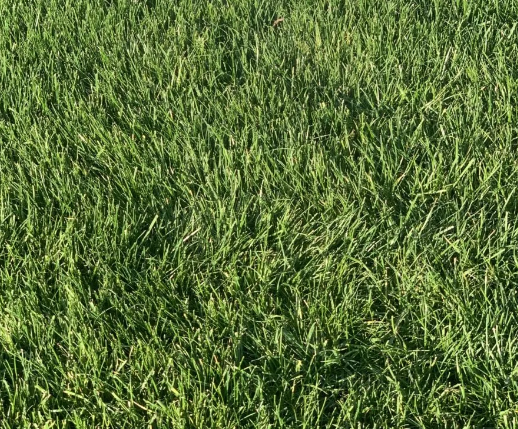
Sun & Shade Lawn Seed Mix
Designed to provide rapid germination and establishment, providing a quality turf requiring normal to low maintenance. It is best used where conditions provide medium amounts of sun and shade. It will provide a quality turf on a variety of soil conditions. The Kentucky Bluegrass used has some shade tolerance and provides excellent turf density and pest resistance when maintained as mentioned above. The Perennial Ryegrass can germinate and establish quickly and provide protection for the slower germinating grasses along with improved disease resistance. The Turf Type Tall and Chewings Fescue add shade tolerance to the turf stand and will perform in a low maintenance environment. All of the grasses used in this mixture blend nicely in both color and leaf texture.
Recommended Use: Sun & Shade Lawn Seed Mix is designed to perform best in areas that have 30% to 50% shade. It can be used successfully on a variety of soils existing in most sites, including home lawns, commercial properties, parks, schools, and other turf areas receiving normal to low maintenance.
Tuff Turf Lawn Grass
TUFF TURF Lawn Seed Mixture® is a combination of improved turf-type Tall Fescues with Perennial Ryegrass and Kentucky Bluegrass. This mixture has excellent drought tolerance, wear tolerance, and will perform nicely in a variety of soil conditions. Tuff Turf will adapt to full sun to reasonably heavy shade conditions. It is best used where budgets dictate that input levels are low and in fact low levels of input are preferred.
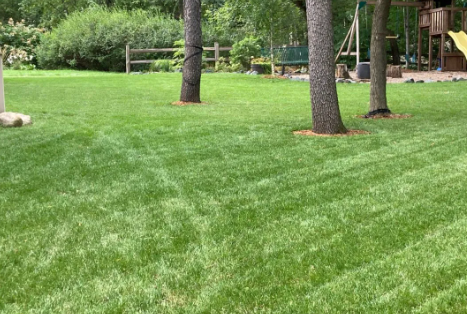
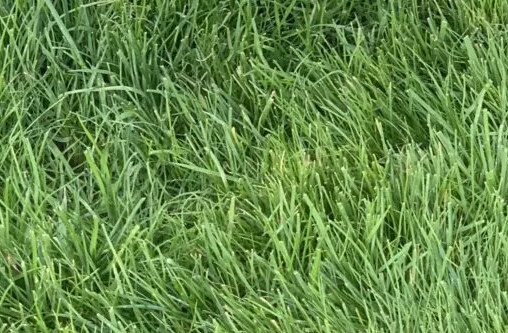
Dense Shade Lawn Mix
Designed for use where sunlight is limited, and turf is desired. A higher percentage of fine & Turf Type Tall fescues, gives this mixture a near maximum shade tolerance in turfgrass situations. The Kentucky Bluegrass used in this mixture exhibits some shade tolerance as well. An improved variety of Poa trivialis lends further shade adaptation and is well suited for wet shade conditions. This combination of grasses is ideal for areas with limited sunlight exposure. All of the grasses used in this mixture blend nicely in both color and leaf texture.
Recommended Use: Dense Shade Lawn Seed Mix is designed to perform best in areas that have 50%+ shade. As with all turf grasses, however, some sunlight is required for long term survival. It can be used successfully on a variety of soils existing on most sites, including home lawns, commercial properties, parks, schools and other turf areas receiving normal to low maintenance.
Bee Lawn Seed Mix
Bee Lawn Mix is designed to provide high-quality food for our at-risk pollinators while maintaining the typical recreation associated with the turfgrass lawn. Bee lawns are low-input, meaning that they are environmentally-friendly as they require fewer inputs of water, mowing, and fertilizer as compared to a traditional lawn. University of Minnesota research has shown that bee lawns can support more than 60 species of bees! Protect pollinators and improve your carbon footprint by planting a bee lawn!
Suggested maintenance: Bee lawns are low maintenance after they are established. Be sure to implement a light and frequent watering program after seeding. Once mature, we recommend maintaining bee lawns at a slightly taller height than what is typical of a traditional lawn. Letting a bee lawn grow out to 4.5” and cutting back to 3” will be sufficient but allowing the lawn to grow out to 6” and cutting back to 4” will likely result in more blooms (and more food) for the pollinators.
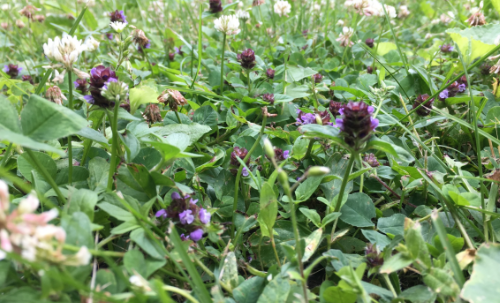
Bee Lawn Deluxe Seed Mix
Bee Lawn Deluxe Seed Mix is designed to maximize floral diversity within the context of the lawn. This mix includes 5 species of flowers, Dutch white clover, creeping thyme, self-heal, Yaak yarrow, and narrow-leaved blue-eyed grass. Each species in the mix blooms at 6” or lower and provides high-quality forage for our at-risk pollinators.
Suggested maintenance: Bee lawns are low maintenance after they are established. Be sure to implement a light and frequent watering program after seeding. Once mature, we recommend maintaining bee lawns at a taller height than what is typical of a traditional lawn. Letting a bee lawn grow out to at least 6” will ensure that all flowers within the native bee lawn mix are able to bloom.
Photos courtesy of Twin Cities Seed Co.
FERTILIZING AND WEED CONTROL
STEP 1
Can be applied anytime, but Mid-April to Early May is a good time to start the season.
Fertilome For All Seasons II
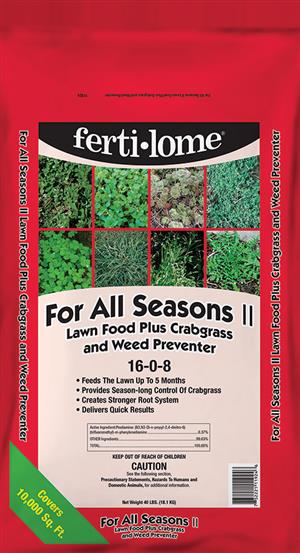
Apply in early spring or fall 2 to 3 weeks prior to seed germination to obtain control of grassy and broadleaf weeds. For use on warm and cool season grasses.
DO NOT USE with new lawn seedings as it will prevent grass seed from germinating. Instead, use Scotts Step 1 for Seeding
Controls Henbit, Oxalis, Poa Annua, Chickweed, Crabgrass, Foxtail, Purslane, Shepherd’s Purse, Prostrate Spurge, Knotweed and others listed on label.
40lbs Coverage: 5,000 sq. ft.
Scott’s Step 1 for Seeding
If you’re looking for lawn fertilizer and crab grass prevention to use on your newly seeded lawn, Scott’s Step 1 for Seeding is the way to go.
This will give you crabgrass prevention without hindering grass seed germination, which other weed preventers will do.
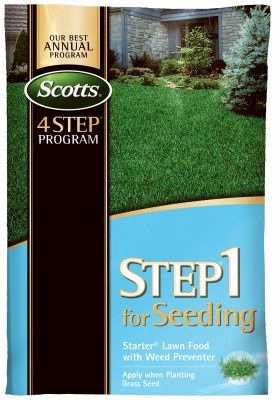
STEP 2
Can be applied in June.
Fertilome Weed-Out Plus Lawn Fertilizer
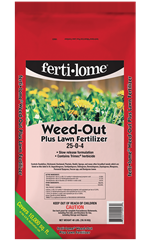
Provides excellent post-emergent broadleaf weed control on cool and warm season grasses.
Results in 7 to 10 days.
Coverage: 5,000 sq. ft.
Lawn should be slightly wet before application, but do not water for 24 hours after application
Contains three weed killers to stop Dandelions, Spurge, Dollar Weed, Wild Onion, Chickweed, Clover and over 200 broadleaf weeds, many of which are listed on the label.
STEP 3
Usually applied in July of August
Classic Lawn Food
DO NOT Apply to stressed or drought-stricken lawns as it can cause more stress or burn lawns. Avoid applying in extreme heat.
Contains Polymer Coated and Sulfur Coated Urea which provides gradual, long-lasting release of Nitrogen to promote optimal uptake by lawn grasses. This formulation has proven to be the best for Southern lawns as well as cool season grasses.
One application lasts for up to 2 months. Slow released Nitrogen formulation reduces lawn growth and grass clippings.
Coverage: 5,000 sq. ft.
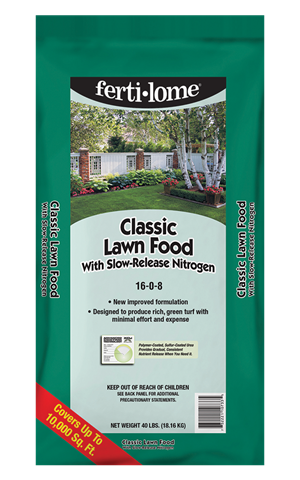
STEP 4
September or October
Winterizer for Established Lawns
DO NOT Apply to stressed or drought-stricken lawns as it can cause more stress or burn lawns. Avoid applying in extreme heat.
Contains Polymer Coated and Sulfur Coated Urea which provides gradual, long-lasting release of Nitrogen to promote optimal uptake by lawn grasses. This formulation has proven to be the best for Southern lawns as well as cool season grasses.
One application lasts for up to 2 months. Slow released Nitrogen formulation reduces lawn growth and grass clippings.
Coverage: 5,000 sq. ft.
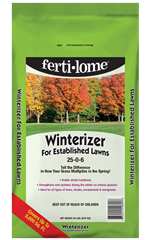
Weed Prevention
Pre-emergents can be applied anytime, but early spring–after the snow is out–is the best time. Do not apply to garden beds or lawns that you will be direct-seeding as these products PREVENT SEED GERMINATION.


